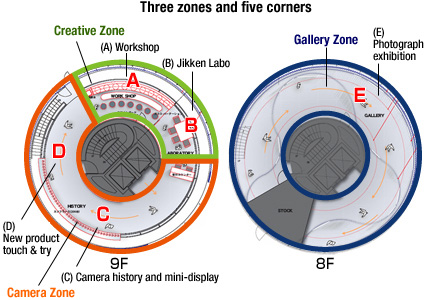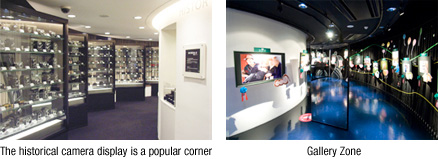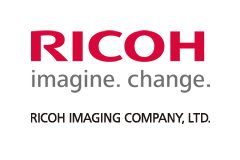Inside Story
A space taking full advantage of its Ginza location
"I wanted to create the kind of space where people can make new discoveries every time they visit," said Hashimoto concerning the space design concept. "What we are striving for is a place that transforms itself for each exhibition, a place where mutual communication is possible, and a place that can change its form to fit the changing times." Most galleries have a rectangular space. The space design for RING CUBE's doughnut shape presented a considerable challenge. "Thinking that we ought to make use of the surrounding glass-panel walls, we ended up throwing out the initial space design and starting again from scratch," Hashimoto added.
Initially the plan was to put a wall around the circumference, but in order to preserve the Ginza view, curtains were hung instead. Sometimes photographs are exhibited with the curtains left open to create a synergistic relationship between image and background. This is a "special effect" made possible by the Ginza 4-chome location.
Three zones and five corners for the enjoyment of cameras and photographs
RING CUBE consists of the Creative Zone, the Camera Zone, and the Gallery Zone. Within these zones, there are five corners in total. These corners were created as places for the creation of new photo culture.


Coming in through the ninth floor entrance, the first thing the visitor finds is the Camera Zone display of all Ricoh cameras, old and new. Beyond that is the Creative Zone, where workshops are held and where photo books can be freely viewed. The Gallery Zone is on the eighth floor. It is a space that can change form with each exhibition.
An experimental photo gallery where the space itself and the display method are an integral part of exhibition design
"For every exhibition, we agonize about how best to present the various individual characteristics of the 'creators.' We try to, as much as possible, showcase the distinctive qualities of the work and the person, and we try to create a space that can marry those qualities to the feelings of the viewer. For this reason, we sometimes don't limit ourselves to a "just view still images in stillness" type of format," said Hashimoto. Up to now, RING CUBE has tried combining still images with music, video, and scents.
"Since we have gone beyond the standard concept of the 'photo gallery,' there is an experimental aspect to RING CUBE. This being the case, our efforts have elicited a variety of opinions, both positive and negative. We continue to take on new challenges, however, because if we don't try new things we won't know whether something works or not and we won't make new discoveries," said Noguchi.
One year after the October 2008 opening, RING CUBE held its 14th exhibition. "We have already developed plans for our next one-year period," said Hashimoto. "If we relied on just Ricoh personnel, our corporate character as a camera manufacturer might have too strong an influence. So we are recruiting support members, known as 'doughnuts,' from among members of the general public who support the RING CUBE concept. They are involved in our plans and projects from a variety of perspectives."
In the next two installments we will see how those plans are both exciting and experimental, and we will take a look at the activities of the doughnuts support member as well as workshops, Jikken Labo, and other things.


